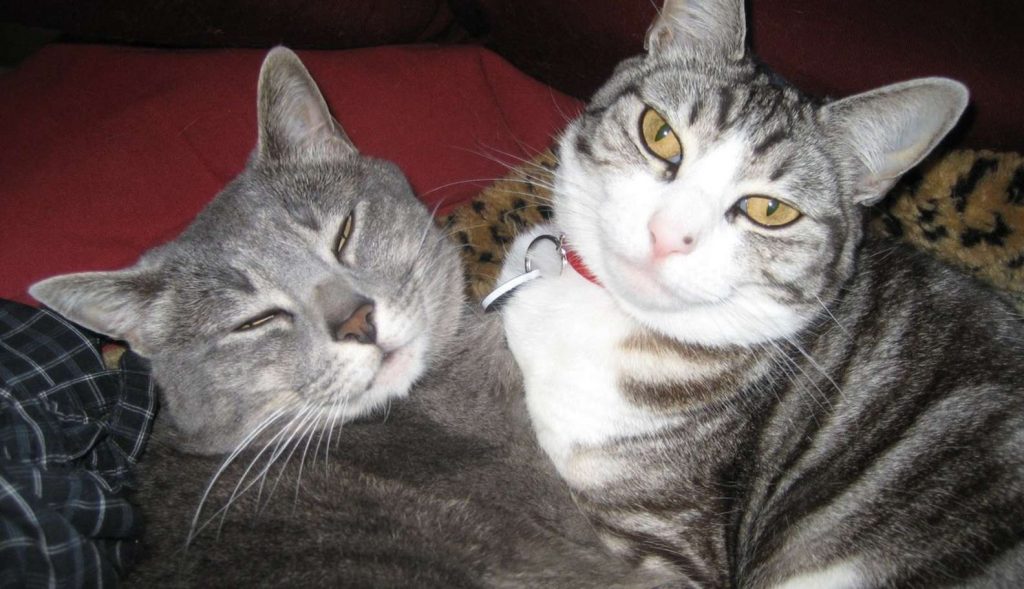I wrote this for the Dodo, inspired by the latest internet craze for cats, and what I feel is an over the top response to the hero cat, Tara, who saved a boy from a dog bite (whether on purpose or not is another story). What I didn’t like is that this “heroic” response was “rewarded” with Tara being brought to a baseball game to throw the first pitch. For various reasons (including the cat’s safety) I don’t think that was the best idea. I don’t like that the main way that cats get positive attention is by being cool or out of the ordinary – so I wanted to let the world know that cats are cool just because they are cats! Not because they are internet celebrities.
Part 1 – the Dodo article
My cats don’t go rock-climbing. They don’t have particularly funny markings. They don’t rescue children, and they don’t steal from the neighbors. They’ll never throw a first pitch at a baseball game, or go to SXSW. And they definitely don’t play guitar or ride on Roombas.

What the heck DO my cats do? They snooze in the sun, chase feather wands, play with their catnip mice, climb their cat trees to watch birds, hang out with us on the couch and they love to eat treats. They purr, use their litter boxes and one of them snuggles under the covers with me at night. They can even do a few cute tricks, like sit and high five, but that’s no ticket to feline fame anymore. It’s a simple life, but I think we’re all pretty happy with the arrangement. Why? Because my cats are both just your “average cat” and I’m okay with that.
The new-found popularity of cats on the internet is great — cats are getting more attention than ever before, and being a “cool” pet will hopefully lead more people to consider adopting a cat when they might not have otherwise. But this fame seems to come with a new pressure — the pressure to be an “extraordinary” cat.
Many years ago, I worked on the set of an audition for a TV game show for cats, assessing potential feline contestants for their TV-readiness. I had the tough job of deciding whether a cat was ready for a screen test, and telling the owners “no” when their cat had been rejected. My role was to ensure that any uncomfortable or stressed out cats were promptly sent on their way home. What was surprising to me was how determined some owners were that their cat get a chance at fame (oh, and a million dollars). It felt a bit “Toddlers & Tiaras” at times. These cats were primped and preened.
Some of the cats were hissing, growling, hiding or even eliminating in their carriers. Those cats were a quick and easy “no.” But their owners would often argue with me, begging for their cats to be given a screen test! The quest for money and fame was blinding them from the fact that their cat was in no way interested in this whole process (and was in fact quite stressed out)!
So how do you know if your cat is cut out for fame? If your cat hides when the doorbell rings, or hates traveling in a carrier, or has serious aggressive episodes under pressure, she’s probably not ready for her 15 minutes. The signs of stress in cats can vary, but hiding or shaking, tail swishing, a tight, tense body and hissing, growling or swatting are all signs that your cat is less than thrilled with his current situation.
Regardless of your cat’s confidence, in any new situation you should assess how safe and appropriate it is for cats. Some questions to ask: is my cat securely contained in their carrier or on a cat-friendly harness? What are the risks if my cat escaped (one of the biggest dangers to traveling cats is getting lost in an unfamiliar area)? Are there other uncontained animals (such as off-leash dogs) I should be worried about?
I’m not saying that cats shouldn’t ever be on TV or at events, or that people shouldn’t train their cats or socialize them to new experiences (especially at a young age, when this training can have PROFOUNDLY positive aspects on their later lives). But I am saying that people should recognize that their cat may not be well-suited to being a celebrity, that a situation might not EVER be appropriate for cats (like being loose in a baseball stadium) and that your cat may prefer the quiet life back at home on the couch.
So, if your cat doesn’t do anything extraordinary — that’s okay — because “just” being a cat is pretty cool already.
Part 2: the cat circus!!
That said, a few days later, I found my self at the Acro-Cats Circus.
Now, I’m no fan of the typical circus, where animals are forced/coerced to perform tricks for human entertainment – and I’m pretty particular when it comes to how cats are treated – trust me, I entered the venue with a combination of dread and excitement. And we can debate whether the Acro-Cats are being exploited (feel free to leave comments! my cat behavior consulting colleagues seemed to be of split minds on this one) and I don’t know what life in the tour bus is like for them. But that said, I was really impressed with what I saw during their performance.
These frisky felines appeared confident, relaxed, engaged and so responsive and interactive with humans. They were very excited to earn their tidbits of roasted chicken, tuna and salmon. The Acro-Cats are all trained using positive reinforcement (clicker training) and Samantha Martin does a great job of promoting the use of clicker training with pet cats, and she does her own rescue and adoption of kitties as well! She even sells a reasonably priced training kit (including a target stick, clicker and whistle) that people can take home (along with plenty of other Acro-Cats swag).
Are the cats well-trained? Yes. Did they wander off and do their own thing from time to time? Definitely yes. A big part of the fun of the show was that the cats weren’t forced or expected to be perfect at their tricks. They often chose to rub on the hoop instead of jump through it; one kitty was more excited to run around than do any tricks; and the band (the Rock Cats) wasn’t exactly “tight.”
But the show was so entertaining, the audience and cats all seemed to be having fun, and I never felt like the cats were stressed out or afraid – something I was watching closely for. I saw a lot of affiliative body language, mainly a lot of raised tails and flank rubbing on people and objects.
Some things I found very interesting: most of the Acro-Cats are females and many of them were bottle-raised – meaning that they were handled a lot by humans during their sensitive period. What is the sensitive period? It’s the time when animals learn about the world – what is safe, what they will encounter as adults, and who they should interact with – including humans and other animals.
One key difference between cats and dogs is the length and timing of this sensitive period. For dogs, this period lasts until 12 weeks of age, but for cats the sensitive period is 2-7 weeks of age. What this means is that by the time most cats are adopted (usually after two months), they’re already past this sensitive time, which makes it hard (although NOT impossible) to socialize them to lots of new experiences. They have an earlier and shorter period in which to learn about the world, making socialization a little trickier.
It’s possible that the Acro-Cats are good at what they do because they were handled at a young age, or that Samantha Martin selects her cats very well – choosing cats with a temperament suited to performing in public and doing cute tricks. While it’s not a lifestyle I would recommend for all kitties, I have to say that I left the Acro-Cats show pleasantly surprised, and with even a bit of longing to leave it all behind, to run away and join the cat circus.




I love this! And yes, bottle-raised cats are awesome (not that I’m biased or anything).